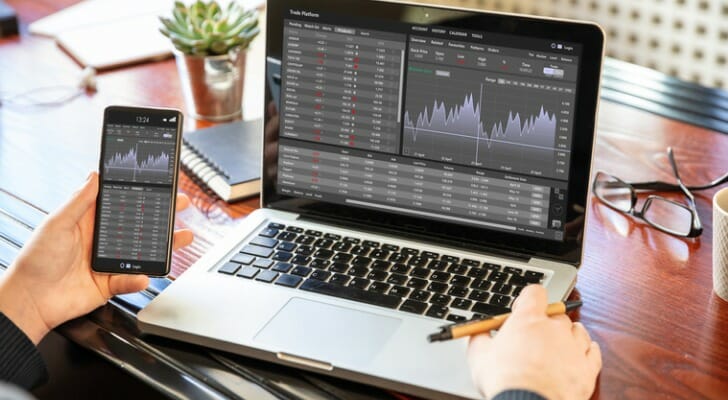Investing is a complicated process, so the trading platform you use should possess the appropriate technology to simplify the process. Both TradeStation and TD Ameritrade’s thinkorswim understand this, delivering dynamic investment tools for active traders. However, every investor has different needs. Choosing the right brokerage that fits your personal requirements will only serve to strengthen your investment strategy. Before opening a new account, this is what to consider when weighing your options between TradeStation vs. thinkorswim as your online broker.
A financial advisor can support your investment practices and help you determine the right approach for your financial goals.
Overview of TradeStation vs. thinkorswim
TradeStation and thinkorswim prioritize traders who already have some investment experience. They both demonstrate a continuing commitment to efficiency and accessibility, constantly looking for ways to make themselves more user-friendly for the average investor.
This is evident through their desktop platforms. Both online brokerages feature a desktop interface with multiple data and investing tools that can significantly improve the investor experience. However, beginners to investing may struggle with the learning curve both services pose.
However, thinkorswim may be the more approachable of the two. It offers paper trading to help beginners practice before using their own money. Although it does not have the same range of investment options as TradeStation, it still offers foreign exchange, which TradeStation does not.
TradeStation vs. thinkorswim: Fees
When comparing TradeStation vs. thinkorswim, both are like many online brokers these days in terms of their stock ETF costs. Both have dropped the investment fees that brokerages used to include and now offer them free stock trading.
Beyond that, the two share somewhat comparable pricing, with a few fees varying between the two.
TradeStation
TradeStation no longer offers TS GO as an available commission plan, instead offering its TS Select plan at the same price for desktop, web and mobile.
TS Select customers get commission-free trades for several types of investments. No minimum deposit is required, but the following fees apply.
Trading Fees
| Trade | Fee |
| Stocks, ETFs, stock options, micro options, futures and micro futures | $0 commission |
| Stock option contract | $0.60 per contract |
| Futures contract | $1.50 per side |
| Micro futures contract | $0.50 per side |
| Futures option contract | $0.85 per side |
The firm, which charges a $10 monthly inactivity fee, offers more than 50 leading fund families, none of which are no-transaction-fee mutual funds. Foreign currency (forex) trading is also available.
TradeStation margin rates are available on a sliding scale based on your balance.
TradeStation Margin Rates
| Minimum Balance | Margin Rate |
| Less than $50,000 | 12.5% |
| $50,000 to $499,999 | 11.5% |
| $500,000+ | Negotiated fee |
thinkorswim
For its part, thinkorswim offers investors desktop, web and mobile platforms. You can trade stocks, ETFs, options, complex options (three legs or more), futures and forex on any of these three platforms.
thinkorswim Fees
| Trade | Fee |
| Stocks and ETFs | $0 online commission |
| Options | $0 online base commission $0.65 per-contract fee |
| Futures and futures options | $2.25 per contract |
| Forex | $0 commission |
thinkorswim margin rates are also offered on a sliding scale with a 10.75% base rate.
thinkorswim Margin Rates
| Minimum Balance | Margin Rate | Effective Rate |
| $0-$24,999.99 | Base Rate + 1.825% | 12.575% |
| $25,000-$49,999.99 | Base Rate + 1.325% | 12.075% |
| $50,000-$99,999.99 | Base Rate + 0.375% | 11.125% |
| $100,000-$249,999.99 | Base Rate + 0.325% | 11.075% |
| $250,000-$499,999.99* | Base Rate + 0.075% | 10.825% |
| $500,000+ | Call 877-752-9749 for latest rates | Call 877-752-9749 for latest rates |
TradeStation vs. thinkorswim: Services & Features
TradeStation allows investors access to most mainstream financial products, including equities, exchange-traded funds (ETFs), options, futures and mutual funds. In addition to these typical offerings, you can also choose to invest in cryptocurrency and initial public offerings (IPOs).
Thinkorswim offers the same standard range of financial products, including cryptocurrency. It also adds forex trading to its lineup.
When it comes to accessibility, you have the same three options for TradeStation and thinkorswim: desktop, web and mobile app. Both platforms have similar desktop versions, and it is the most complex interface out of the three versions, offering the greatest range of customizations and data options.
TradeStation has multiple platforms, includingFuturesPlus, which supports options and futures,. For trading, the desktop version offers tools such as Matrix, which is described as the “Swiss Army Knife” of trading tools. It combines an order-tracking system, a market depth window and an order-entry tool, all in one.
thinkorswim also supports sophisticated trading tools. However, it also enables fundamental analysis, a feature many long-term investors rely on. Fundamental analysis entails widgets, including news, analysis and Level 2 data for easy reference.
Although both platforms still have some experiential gap between their interfaces and new investors, thinkorswim supports paper trading, which can help bridge the gap by allowing users real-world practice using a simulated account and fake money. With this, investors can familiarize themselves with not only the program and its tools but also trading as a whole before risking their own money. Both platforms offer educational opportunities to help mitigate this gap, as well.
TradeStation vs. Thinkorswim: Online & Mobile Experience
TradeStation pushes cross-platform use by emphasizing the real-time account sync between its web and mobile trading. The TradeStation app is generally not for the casual investor, although it is less complex than its desktop counterpart.
There is still a highly personalized investment experience, complete with technical analysis tools tou monitor trends and create charts. Both the web and mobile-based platforms offer commission-free trading on stocks and ETFs, but only TS Select subscribers can access free real-time data for the major equity exchanges.
By the same token, thinkorswim carries over its core desktop features into its mobile platform with an emphasis on market monitoring and trading. However, while its tools are more limited, it ends up providing a much cleaner interface for a more straightforward investment experience.
Both brokerages put data and customization at the center of their desktop clients. In comparison to their mobile versions, they are helpful but dense. Beginner investors may not know how to comfortably navigate either system. However, the high number of tools for each platform can help an experienced investor reach a higher potential, although they might need to take time to learn every gadget.
Paper Trading and Simulation Features
One of thinkorswim’s most notable advantages, especially for newer or risk-averse investors, is its robust paper trading feature, called paperMoney®. This simulation tool allows users to trade with virtual money in real-time market conditions.
The paper trading environment mimics the full thinkorswim platform, including access to charts, indicators, trading tools and even complex options strategies. Traders can test their ideas without putting real capital at risk, which is especially helpful when experimenting with unfamiliar asset classes or building confidence before going live.
paperMoney supports equities, options, ETFs and more for a more well-rounded experience. It uses delayed data in most cases to replicate market movement without the pressure of real-world consequences. However, while it is an excellent educational tool, it fails to fully replicate emotional decision-making and does not account for slippage, liquidity issues or investment fees, all of which often occur in live trading.
TradeStation also offers a simulated trading environment, but its tools are more tailored to experienced users. Its simulator mirrors the live trading interface and allows users to execute trades, set up orders and test strategies in a near-identical environment to the real thing. This can be especially valuable for testing algorithmic trades or complex setups.
However, TradeStation’s paper trading features are slightly less approachable for beginners compared to thinkorswim’s user-friendly, tutorial-rich experience.
Who Should Use TradeStation?
When compared to other top brokerages like Ally Invest or Fidelity, TradeStation is not the lowest-cost trading platform available. It is also not the simplest, so beginner investors may struggle to use it. However, advanced traders are sure to benefit from its wealth of market data, tools and investment options. Its overall layout is sophisticated, catering to a particular type of trader.
Investors with a TS Select account may find the desktop version particularly appealing because it is the most comprehensive and allows for a more complex and customized investment experience.
Who Should Use thinkorswim?
Like TradeStation, thinkorswim’s platform is designed to suit advanced traders more than beginner investors with its tool-heavy system.
Still, it offers more opportunities that could be valuable to a new trader than TradeStation, depending on your experience. The simulated investment program is a great way to familiarize a client with a complex system. Plus, the platform offers some analysis tools that TradeStation lacks.
Investors interested in active trading and foreign exchange may find this to be the more appealing choice between the two.
Bottom Line
When comparing TradeStation vs. thinkorswim, you will find that both are complex trading platforms offering a considerable amount of tools for active investors. While they may not be the best fit for more inexperienced and passive investors, the two platforms are working toward opening up to a wider audience. Therefore, they may be worth exploring in the future if they are not the right online broker for you right now. Meanwhile, active investors can continue to take advantage of the opportunities the two present, enjoying a customized and convenient trading experience.
Consider asking a financial advisor about the best investment strategies to use with TradeStation or thinkorswim based on your long-term goals.
Tips for Investing
- A financial advisor can help you see your investment strategy in a new light and help you become a better investor. If you don’t have a financial advisor yet, finding one doesn’t have to be hard. SmartAsset’s free tool matches you with up to three vetted financial advisors who serve your area, and you can have a free introductory call with your advisor matches to decide which one you feel is right for you. If you’re ready to find an advisor who can help you achieve your financial goals, get started now.
- Make sure your investment assets fit your risk profile. SmartAsset’s free, easy-to-use asset allocation calculator will help align your assets with your risk tolerance.
- If you’re considering an online investment platform, it’s important to research each one before you choose. You can read our detailed brokerage reviews, like the ones we’ve done on TradeStation and thinkorswim to get you on the right path.
Photo credit: ©iStock.com/andresr, ©iStock.com/Rawf8, ©iStock.com/kasto80


